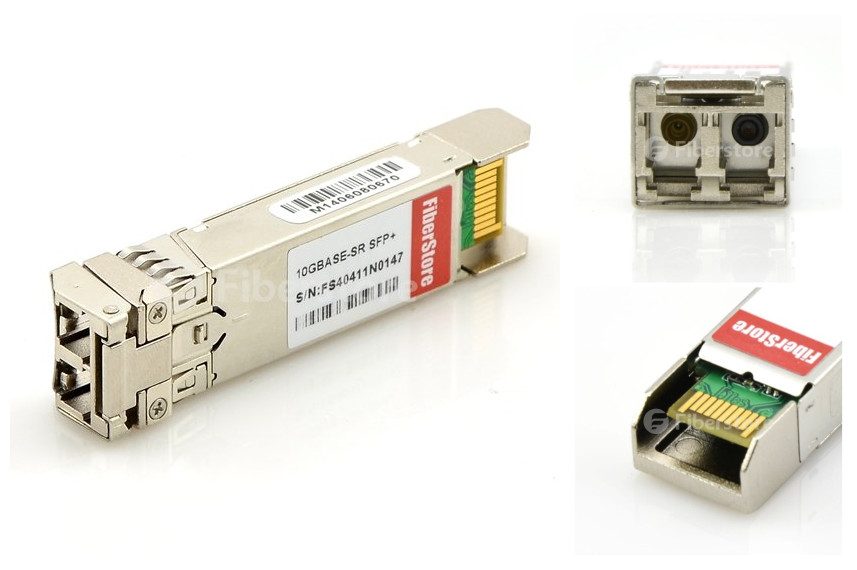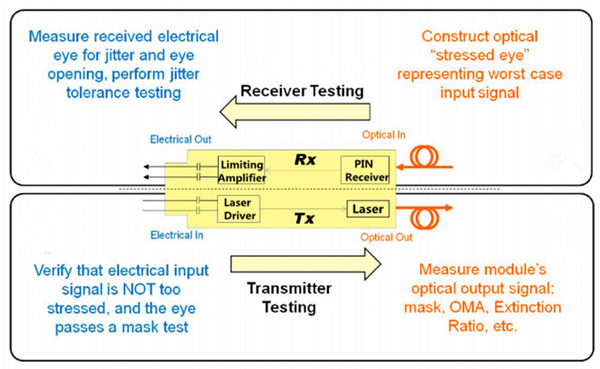April 11, 2016
Most optical networks today use components that may come from various suppliers, which makes it particularly important to test the compatibility and interoperability of each fiber optic transceiver in the network. In a network with SFP+ transceivers, verifying the performance of them when they are first deployed is necessary and straightforward. How to test an SFP+ transceiver module to make sure that it can function well? It will be discussed in the following text.
SFP+ is a hot-pluggable multi-rate optical transceiver for data communications and storage-area network (SAN) applications. As SFP+ transceiver becomes more pervasive, engineers need to become more familiar with some of the key challenges linked to testing SFP+ capable devices. We know that basically an SFP+ transceiver consists of a transmitter and a receiver. When a transmitter connects with a receiver through a fiber, the system doesn't achieve your desired bit-error-ratio (BER). Where is the problem? Is it the transmitter or the receiver? Perhaps both are faulty. A low-quality transmitter can be compensated by a low-quality receiver (and vice versa). Thus, specifications should guarantee that any receiver will interoperate with a worst-case transmitter, and any transmitter will provide a signal with sufficient quality such that it will interoperate with a worst-case receiver. The picture below shows a Brocade 10G-SFPP-SR 10GBASE-SR SFP+ transceiver.

The test of an an SFP+ transceiver module can be divided into two parts: the transmitter testing and the receiver testing.
SFP+ Transmitter TestingSFP+ transmitter parameters may include wavelength and shape of the output waveform. There are two steps to test a transmitter:
1. The input signal used to test the transmitter must be good enough. Measurements of jitter and an eye mask test must be performed to confirm the quality using electrical measurements. An eye mask test is the common method to view the transmitter waveform and provides a wealth of information about overall transmitter performance.
2. The optical output of the transmitter must be tested using several optical quality metrics such as a mask test, OMA (optical modulation amplitude), and Extinction Ratio.
SFP+ Receiver TestingSFP+ receiver may specify tolerance to jitter and bandwidth. To test a receiver, there are also two steps:
1. Unlike testing the transmitter, where one must ensure that the input signal is of good enough quality, testing the receiver involves sending in a signal that is of poor enough quality. To do this, a stressed eye representing the worst case signal shall be created. This is an optical signal, and must be calibrated using jitter and optical power measurements.
2. Then, testing the electrical output of the receiver must be performed, which includes three basic categories of tests:
- A mask test, which ensures a large enough eye opening. The mask test is usually accompanied by a BER (bit error ratio) depth.
- Jitter budget test, which tests for the amount of certain types of jitter.
- Jitter tracking and tolerance, which tests the ability of the internal clock recovery circuit to track jitter within its loop bandwidth.

During the process of SFP+ transceiver testing, there are several challenges that you need to pay attention to. One challenge is moving seamlessly from a compliance environment to a debug environment. If a measurement fails, how can the designer determine which component is causing the failure and debug the issue to arrive at the root cause? Another problem that most designers face today relates to connectivity: how to get the signal out from the device under test (DUT) to an oscilloscope. Yet another challenge is the increased port density and the testing time required with 48 or more ports per rack.
An SFP+ transceiver' performance is very critical to a whole nework, so it is an indispensable step to ensure its performance. Both transmitter test and receiver test are needed. Fiberstore provides all kinds of compatible SFP+ transceivers branded by Cisco, HP, Arista, Brocade, etc., like Avago AFBR-709SMZ compatible SFP+ module. Every SFP+ transceiver from Fiberstore has been tested carefully to guarantee superior quality.
Posted by: jowang at
09:08 AM
| No Comments
| Add Comment
Post contains 680 words, total size 6 kb.
35 queries taking 0.0277 seconds, 70 records returned.
Powered by Minx 1.1.6c-pink.









